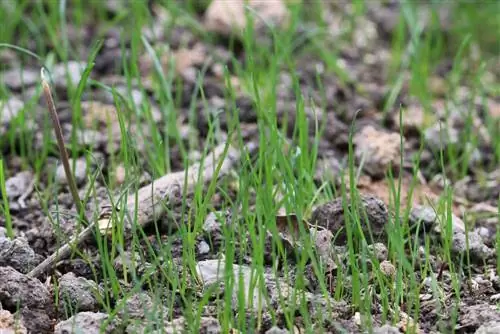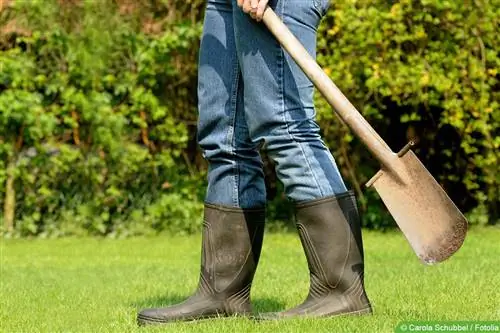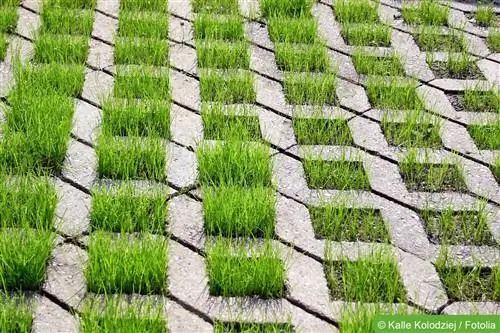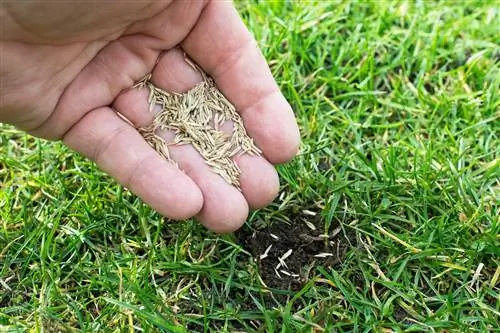- Author admin [email protected].
- Public 2023-12-17 03:39.
- Last modified 2025-06-01 06:48.
If your lawn has large unevenness, you will not be able to avoid digging it up. You have to completely renew the lawn and rebuild it from below. Such a thorough renewal may also be necessary if there is heavy weed growth on the lawn or if you want to change the type of lawn. Don't just grab a spade. As a rule of thumb, if you have tried the gentle method twice without success, it makes more sense to dig rather than try gently again.
Renewing the lawn - step by step
A completely new plant with digging should be done in early autumn. The gentle method, which experts call seamless renewal, is possible from May to September. Choose a time for the preparatory work shortly before you expect wet weather for a long period of time.
Preparing the area for renewal
Mow the grass as short as possible with your lawnmower. If your mower cannot be used for a short cut, have the grass cut by a gardening company. Then remove all clippings, as this step serves to weaken the existing lawn. The next measure required is thorough scarification. You can borrow suitable equipment from specialist retailers or leave this measure to a specialist company. Thoroughly means that you scarify several times, alternating lengthwise and crosswise. You need a clear view of the ground between the remaining stalks.
Weed killer - yes or no?
When you use a total herbicide, you destroy the remaining grass and weed plants. After the waiting times prescribed for the respective product, you will have an area that is optimally prepared for the new sowing because the area is completely free of plants. But with these means you are causing damage to the ecosystem. Small creatures that live in the lawn will die if this is done. There is also a possible danger to children, pets and wild animals. You should consider whether a beautiful lawn is worth these disadvantages.
Plan further measures
Your lawn looks bare after scarifying. This has the advantage that you can detect unevenness such as molehills or mouse burrows that have collapsed underground. Level such areas with a spade. If you need to pile up soil in places, tamp it down firmly. Wait a few days before sowing, you will usually have to add more soil.
Sowing the new lawn

You need a spreader for larger areas because it is very important that you first spread phosphorus fertilizer and then spread lawn seeds evenly. Practical experience has shown that the lawn grows more evenly if you spread the fertilizer lengthways and the seeds crosswise. Be sure to seek advice from your local specialist retailer when selecting seeds. They know the climate there and know which varieties thrive. Cover the newly sown area with a thin layer of peat. This ensures a good connection to the ground and shows when the area needs to be irrigated. Since grass is a light germinator, the layer must not be thicker than 0.5 centimeters.
Water and fertilizer for lush greenery
The seeds must be kept constantly moist for the next four weeks. If it doesn't rain, you need to use a lawn sprinkler to let artificial rain fall on the seeds for ten minutes up to five times a day. As soon as the peat turns light in color, the soil is too dry and must be wetted immediately. After six weeks, further fertilization with slow-release fertilizer is necessary.
Renew lawn by digging it up
If the measures mentioned so far have not been successful, thinly remove the old turf with the spade. Layer them upside down in the compost. Cover the soil with a two-inch layer of coarse sand before digging to a spade depth. Break up the soil with a digging fork. Stones and old roots are also removed on this occasion. After a few days, the ground can be smoothed out with a rake and, if necessary, leveled by removing or filling it. Roll the area with a lawn roller. If there are large uneven areas, expect to have to smooth them several times. Wait until the soil no longer settles before sowing.
Sowing new grass
As already described with the gentle method, you now need phosphorus fertilizer and a lawn mixture that is suitable for your climatic conditions. Spread fertilizer and grass seeds with a spreader as described. Since the soil is loose, you don't need peat. Work the seed lightly into the soil with the rake. Roll over it again with the lawn roller. Grass needs a soil temperature of plus ten degrees Celsius to germinate. If the work has dragged on for too long, sow foundation and wait until next spring to sow the lawn. The foundation prevents weeds from growing in the open area. You have to dig and roll again before sowing. The rest of the new creation is carried out as described for the break-free method.
What you need to know about renewing your lawn soon
Are you complaining about thin lawns and bare spots? Then you should make sure that you regularly supply the lawn with enough air. With this so-called aeration, it is enough to poke a few holes in the ground with a suitable tool and then fill them with gravel if necessary. But be careful, if you dig too deep into the ground, it will compact again and you will have achieved exactly the opposite.
If a lawn has dried up in the summer so that nothing can be done with water, then the only thing that helps is to remove the dry grass and replant the lawn. This often only affects smaller areas, so it is important to sow the same lawn again so that an even picture emerges again. There are also special reseeds that you can get from specialist retailers. This is more expensive, but the seeds grow faster and the gaps are closed more quickly. This means that weeds also have fewer chances.
Basically, you should renew your lawn every now and then without it causing problems or drying out. This is best done in May, August or September:
- During this renewal, the lawn is initially cut very short.
- Then it will be scarified. Scarifying can then ideally be repeated several times.
- The lawn is then limed. It's best to do it early in the morning or late in the evening. But beware! Do not overscale.
- The area is then watered well to create the right conditions for the new seeds.
- The weeds are being pulled out. This is a very laborious and time-consuming process, but you will see that it is worth it!
- Now you can lightly rake up the soil and incorporate some fertilizer.
- Then the new seeds are finally ejected, which is done very regularly with a spreader.
- Last but not least, regular watering is important. The lawn shines in new splendor about three weeks later.






